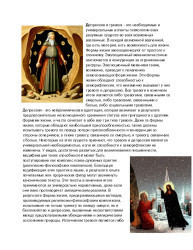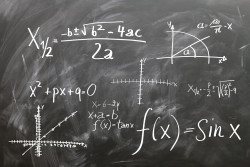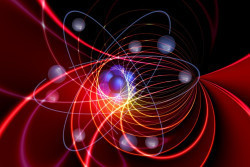<p>Dr. Jonathan Kenigson, FRSA (Fellow of the Royal Society of Arts, UK).<br>Quarks are the smallest known particles, and they are the building blocks of all matter. There are six different types of Quarks—known as ‘flavors’—which are represented by the designations up, down, charm, strange, top, and bottom. Each flavor of Quark has an associated particle and antiparticle, which are distinguished by having opposite Noether Charges. Quarks interact with each other through the Strong Nuclear Force, and they also carry fractional electric charges. Quarks can be combined to form larger particles such as Protons, Neutrons, and Mesons. These particles, in turn, make up the atoms of all known matter. Quarks are not found in isolation, and they are still impossible to observe in a laboratory due to their extremely short lifetimes. Quarks are fundamental elements of the Standard Model and are amenable to mathematical discussion via Coupling Constants. Yukawa Coupling is an important concept in particle physics and is named after Japanese physicist Hideki Yukawa. It explains the interaction between a scalar field and Fermions, which are particles that obey Fermi-Dirac statistics. It is used to describe the interaction between Nucleons and Pions, which are particles that mediate the Strong Interaction. The strength of the Yukawa Coupling is determined by a parameter known as the Yukawa Coupling Constant. This constant is important as it tells us how strongly two particles are bound together. The Strong Nuclear Force is a fundamental force of nature that binds together the particles that make up the nucleus of an atom. It is one of the four fundamental forces of nature, alongside the Weak Nuclear Force, Electromagnetism, and Gravity. The Strong Nuclear Force is much stronger than the other forces — up to 137 times stronger than the Electromagnetic Force — which is why it can provide the binding energy to hold together the particles in the nucleus. It works by exchanging particles called Gluons, which have no mass and act as a "glue" to hold together Nucleons (Protons and Neutrons). The Strong Nuclear Force is incredibly powerful and has an incredibly short range — it only works at distances of less than a femtometer. This means that it only works within the nucleus of an atom, and it becomes weaker as the particles get farther apart.A mathematically robust understanding of Yukawa mechanisms may shed light on why certain natural constants assume bizarrely specific and ostensibly unintuitive values. The Planck Constant is a fundamental physical constant that is essential to quantum mechanics. It was first postulated by Max Planck in 1900 and has since become one of the most important constants in physics. It is expressed as h, where h = 6.626 x 10-34 Js. The Planck Constant is used to calculate the energy of a photon, the quantum of energy in a particle of light. It is also used to calculate the frequencies of Electromagnetic radiation. Furthermore, the Planck Constant is used to calculate bounds in the Heisenberg Uncertainty Principle, which states that it is impossible to measure both the position and momentum of a particle simultaneously. The Fine Structure Constant, also known as the Sommerfeld Constant, is one of the most important constants in physics. It is a dimensionless constant, which means its value does not depend on the system of units used. The Fine Structure Constant is the ratio of two fundamental constants in physics: the speed of light and the Planck Constant. It is used to calculate the Coupling Constant of the Electromagnetic Force and to measure the energy of an atom's Electrons. The Fine Structure Constant is also used to calculate the Bohr radius, the radius of the hydrogen atom's ground state. This constant is essential for understanding the structure of atoms and is crucial for quantum mechanics and nuclear physics. The Gravitational Constant, also known as the universal Gravitational Constant, is a fundamental physical Constant used in the calculation of Gravitational Force between two objects in the universe. This number, denoted as G, is equal to 6.674 x 10-11 Nm2/kg2 and is usually expressed in scientific notation. It expresses the strength of the Gravitational Force between two objects - the larger the constant, the stronger the Gravitational Force. This constant plays an important role in many areas of science, from determining the orbits of planets to understanding the behavior of black holes. It is also used in the calculation of the mass of a star and other astronomical bodies. The speed of light in a vacuum is one of the most important constants in physics. It is the maximum speed at which all forms of energy, including light and Electromagnetic radiation, can travel through a vacuum. This speed is constant, and is equal to approximately 299,792,458 m/s. This means that the speed of light in a vacuum is significantly faster than any other speed that humans can achieve, making it an essential tool in modern science and technology. The speed of light in a vacuum has far-reaching implications for the fields of physics, astronomy, and mathematics. It can be used to calculate the distance between stars and galaxies and is a key factor in the theory of relativity.<br>Works Consulted and Further Study.<a href="https://medium.com/@jonathanjkenigson/yukawa-works-cited-74b13eda86df" target="_blank" data-saferedirecturl="https://www.google.com/url?q=https://medium.com/@jonathanjkenigson/yukawa-works-cited-74b13eda86df&source=gmail&ust=1685566196432000&usg=AOvVaw3gPdZYMv109WKRg4A3Xbwi">https://medium.com/@jonathanjkenigson/yukawa-works-cited-74b13eda86df</a><br></p>

Jonathan Kenigson
2
 Jonathan Kenigson
Jonathan Kenigson
 Jonathan Kenigson
Jonathan Kenigson
 Jonathan Kenigson
Jonathan Kenigson






